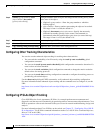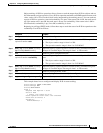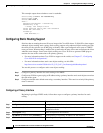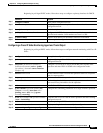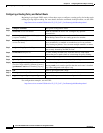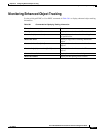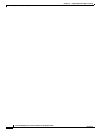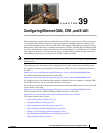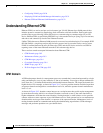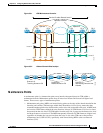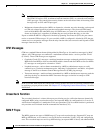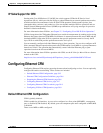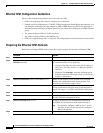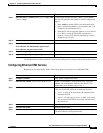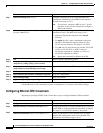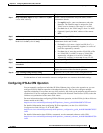
39-2
Cisco ME 3400 Ethernet Access Switch Software Configuration Guide
OL-9639-06
Chapter 39 Configuring Ethernet OAM, CFM, and E-LMI
Understanding Ethernet CFM
• Configuring E-LMI, page 39-26
• Displaying E-LMI and OAM Manager Information, page 39-31
• Ethernet CFM and Ethernet OAM Interaction, page 39-32
Understanding Ethernet CFM
Ethernet CFM is an end-to-end per-service-instance (per VLAN) Ethernet layer OAM protocol that
includes proactive connectivity monitoring, fault verification, and fault isolation. End-to-end can be
provider-edge-to provider-edge (PE-to-PE) device or customer-edge-to-customer-edge (CE-to-CE)
device. Ethernet CFM, as specified by IEEE 802.1ag, is the standard for Layer 2 ping, Layer 2 traceroute,
and end-to-end connectivity check of the Ethernet network.
Unlike CFM, other metro-Ethernet OAM protocols are not end-to-end technologies. For example, IEEE
802.3ah OAM is a single-hop and per-physical-wire protocol and is not end-to-end or service aware.
E-LMI is confined between the user provider-edge (UPE) and the CE device and relies on CFM for
reporting status of the metro-Ethernet network to the customer-edge device.
These sections contain conceptual information about Ethernet CFM:
• CFM Domain, page 39-2
• Maintenance Points, page 39-3
• CFM Messages, page 39-4
• Crosscheck Function, page 39-4
• SNMP Traps, page 39-4
• IP SLAs Support for CFM, page 39-5
CFM Domain
A CFM maintenance domain is a management space on a network that is owned and operated by a single
entity and defined by a set of ports internal to it, but at its boundary. You assign a unique maintenance
level (from 0 to 7) to define the hierarchical relationship between domains. The larger the domain, the
higher the level. For example, as shown in
Figure 39-1, a service-provider domain would be larger than
an operator domain and might have a maintenance level of 6, while the operator domain maintenance
level is 3 or 4.
As shown in Figure 39-2, domains cannot intersect or overlap because that would require management
by more than one entity, which is not allowed. Domains can touch or nest (if the outer domain has a
higher maintenance level than the nested domain). Nesting domains is useful when a service provider
contract with one or more operators to provide Ethernet service. Each operator has its own maintenance
domain and the service provider domain is a superset of the operator domains. Maintenance levels of
nesting domains should be communicated among the administrating organizations. CFM exchanges
messages and performs operations on a per-domain basis.



